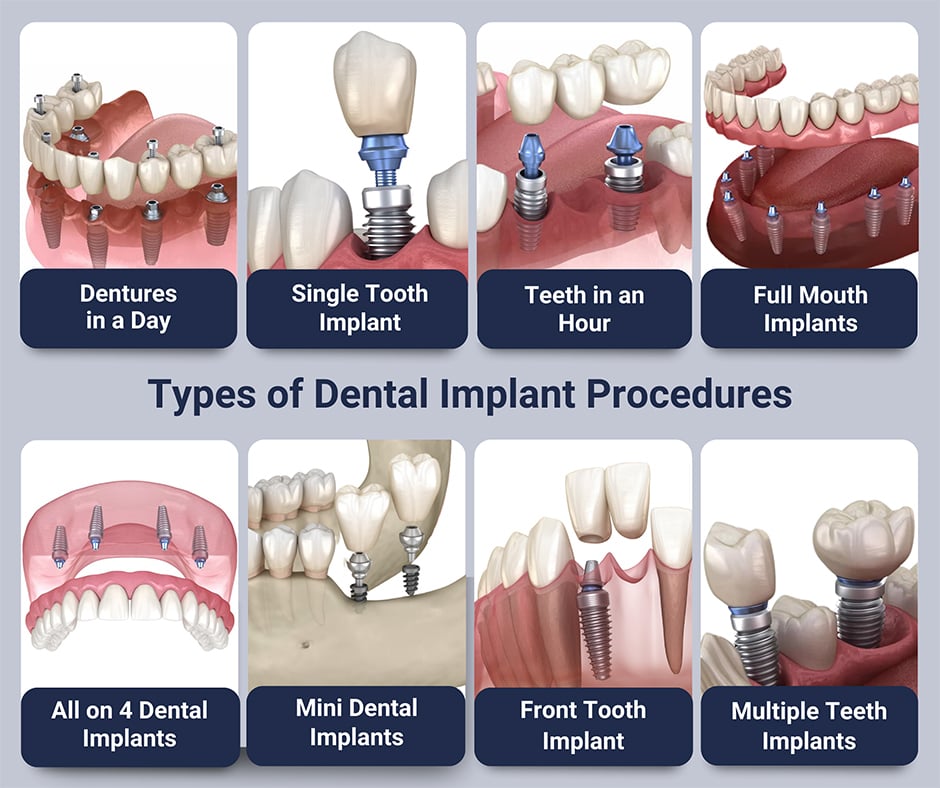The Basic Principles Of Dental Implants
The Basic Principles Of Dental Implants
Blog Article
Little Known Facts About Dental Implants.
Table of ContentsUnknown Facts About Dental ImplantsExcitement About Dental ImplantsGetting My Dental Implants To WorkThings about Dental Implants
are medical tools operatively dental implanted into the jaw to restore an individual's ability to eat or their appearance. They give support for man-made (fake) teeth, such as crowns, bridges, or dentures. When a tooth is shed as a result of injury or illness, a person can experience complications such as fast bone loss, defective speech, or changes to chewing patterns that result in discomfort.
Framework of The Oral Implant System selecting dental implants, talk with your oral supplier about the potential benefits and threats, and whether you are a prospect for the treatment. Things to take into consideration: Your overall wellness is a crucial consider figuring out whether you are a good prospect for oral implants, the length of time it will certainly require to heal, and the length of time the dental implant may remain in location.
Smoking might impact the healing process and decrease the lasting success of the dental implant. The healing procedure for the implant body might take numerous months or longer, during which time you generally have a temporary joint in area of the tooth. the oral implant procedure: Thoroughly follow the oral health guidelines offered to you by your dental copyright.
See This Report about Dental Implants
Implant failing can cause the demand for an additional surgery to deal with or replace the implant system. Recovers the ability to chew Recovers aesthetic appearance Assists keep the jawbone from shrinking because of bone loss Protects the health of the bordering bone and gum tissues Assists keep adjacent (neighboring) teeth steady Improves high quality of life Damage to surrounding all-natural teeth during implant placement Injury to the surrounding cells during surgical procedure, such as sinus opening Injury during surgical procedure (for instance, crack of surrounding jawbone) Insufficient function, such as feeling like the teeth do not bite together typically A feeling that the tooth is loosened or twisting in area resulting from an abutment screw loosening Implant body failing (looseness of the implant body) as a result of systemic infection, which might be much more most likely in clients with uncontrolled diabetics issues due to neighborhood infection in bone and gums supporting the implant body because of postponed recovery, which may be most likely in patients that smoke Trouble cleaning the gums around the dental implant, leading to inadequate dental health Untreated gum condition Post-surgical great post to read feeling numb due to nerve impingement or damages Constantly notify healthcare companies and imaging technicians that you have dental implants before any magnetic resonance imaging (MRI) or x-ray procedures.
FDA is not aware of any negative events reported for MRI or x-ray treatments with dental implants. Dental implants systems are typically made from products that adhere to global consensus criteria of the International Company for Standardization (ISO) or ASTM International. These requirements have details of what makes a safe product.
Dental dental implant systems are reviewed according to worldwide consensus criteria. Biocompatibility screening, to reveal that bodily call with the device does not trigger problems like inflammation or allergic reaction, is component of his explanation the examination that assists guarantee the products in the dental implant system are risk-free and do not trigger negative results when dental implanted in individuals.

Unknown Facts About Dental Implants
Some people are not eligible for oral implant surgery. It is for oral cosmetic surgeons to operate individuals with: intense illnessuncontrollable metabolic diseasebone or soft cells illness or infectionIf these issues are dealt with, an individual can have the surgical procedure. Dental Implants. In, dental surgeons avoid operating people with: If people with any of the above undertake oral implant surgical treatment, there is a greater risk of the implant falling short
Some people have a jawbone irregularity that avoids sufficient bone for an implant from creating. In such cases, a surgeon might need to carry out a ridge modification. This involves raising the gum to expose the area of warped bone. The specialist will certainly then use a bone or bone replacement to repair and develop up the area.
Oral dental implant surgery is a tailored process. Give you time to recover. Connect the blog post and final crown, bridge or denture.
Next off, your doctor will thoroughly put the oral implant into your jaw. If your implant is near the front of your mouth, your dental practitioner will make a temporary tooth for you to wear up until you heal.
The smart Trick of Dental Implants That Nobody is Discussing
Your supplier can tell you what to expect in your circumstance. anchor Throughout the recovery phase, your jawbone must fuse to the oral implant. This procedure, called osseointegration, is important for security and long-lasting success. This process can take anywhere from three to 9 months. In some cases, it might take much longer.
As soon as your implant heals, your dental professional can affix the abutment (tiny connector message) and your last restoration (crown, bridge or denture). This typically takes about one hour to finish and might require a 2nd small surgical procedure. You shouldn't really feel any type of pain throughout your dental implant procedure because your copyright will certainly make use of drug to numb your periodontals.
Report this page